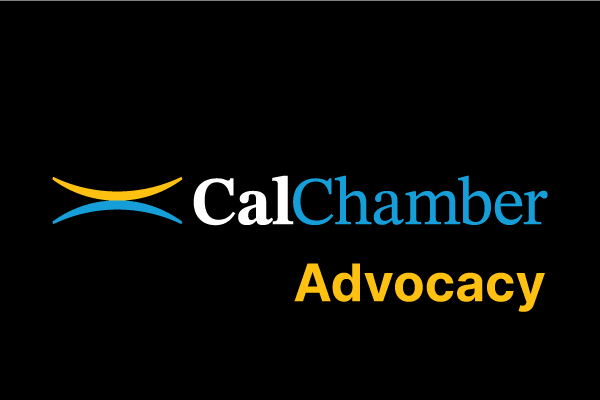 The California Chamber of Commerce this week announced its positions on a number of initiative proposals that have not yet qualified for the ballot.
The California Chamber of Commerce this week announced its positions on a number of initiative proposals that have not yet qualified for the ballot.
The CalChamber Board of Directors has taken positions on the following initiative proposals:
• People’s Initiative to Protect Proposition 13 Savings—Support.
• California Care Act—Oppose.
• California Schools and Local Communities Funding Act of 2018—Oppose.
• Affordable Housing Act—Oppose.
• Fair Pricing for Dialysis Act—Oppose.
• California Consumer Privacy Act—Oppose.
People’s Initiative to Protect Proposition 13 Savings
 The People’s Initiative allows homeowners over 55 years old to sell their homes, move, and transfer their property tax basis to the new residence.
The People’s Initiative allows homeowners over 55 years old to sell their homes, move, and transfer their property tax basis to the new residence.
Proposition 13, passed by California voters in 1978, generally limits ad valorem property taxes to 1% of the full cash value of the property plus a maximum increase of 2% per year. The full cash value is the value of the property in 1975–1976 or “the appraised value of real property when purchased, newly constructed, or a change in ownership has occurred after the 1975 assessment.” Selling a home and buying a different home creates a new tax basis. Since 1978, voters have twice tweaked the portability of the Proposition 13 tax basis:
• Proposition 60 (1988) allowed homeowners over the age of 55 to transfer the assessed value of their present home to a replacement home if the replacement home is located in the same county, is of equal or lesser value, and purchased within 2 years of sale.
• Proposition 90 (1988) extended that transfer to out-of-county purchases provided that the incoming county allowed the transfer.
The proposed initiative further extends the portability of Proposition 13 property tax basis by removing the geographic restrictions in Proposition 60 and Proposition 90.
California is facing a massive housing shortage and needs at least 100,000 additional new units a year to meet demand. The CalChamber Board voted to support this measure because it could help ease the shortage by freeing up modest-priced and move-up housing for young families.
The change is important because seniors, who often are on a fixed income, fear they will not be able to afford a big property tax increase if they sell their existing home and buy another one, discouraging them from ever moving. As a result of this “moving penalty,” almost three-quarters of homeowners 55 and older haven’t moved since 2000. In addition, a recent estimate from the Legislative Analyst’s Office found that this initiative would increase home sales in the tens of thousands per year.
California Care Act
 The California Care Act proposes a surcharge of 1% on all taxable income over $1 million to pay for various health care programs.
The California Care Act proposes a surcharge of 1% on all taxable income over $1 million to pay for various health care programs.
This tax is in addition to the top state personal income tax rate of 12.3% and the existing 1% surcharge on incomes over $1 million. The tax would apply to all taxpayers, regardless of filing status, and would not be indexed for inflation. The Legislative Analyst estimates the tax would raise between $1.5 billion and $2.5 billion annually, depending on economic conditions.
California’s personal income tax is notoriously the highest and most steeply progressive in the nation. Since 2004, voters have approved three income tax increases. Wealthy individuals pay a disproportionate share of personal income tax revenues. The Department of Finance estimates that the top 1% of income earners paid just under 48% of personal income taxes. Since the income tax today accounts for about 70% of General Fund revenues, relatively few taxpayers disproportionately influence state revenues. The state budget is therefore vulnerable to economic cycles and the behavior of these relatively few taxpayers.
The CalChamber Board voted to oppose this measure because increasing income taxes again is unnecessary and potentially risky to California’s economic health and budget stability.
Layering additional tax increases on just a few taxpayers may encourage these taxpayers to source their income in tax-friendlier states, which would reduce economic activity and tax revenues in California. Many small businesses are organized such that their owners pay state taxes through the personal income tax. Another large tax increase—especially in the absence of the federal tax deduction—will penalize small business owners and job creators.
California Schools and Local Communities Funding Act of 2018
 The California Schools and Local Communities Funding Act of 2018 proposes a split-roll property tax on commercial and industrial properties.
The California Schools and Local Communities Funding Act of 2018 proposes a split-roll property tax on commercial and industrial properties.
This measure requires that beginning with the 2020–21 lien date, all commercial and industrial properties, with some exceptions, be reassessed to full market value, and then reassessed every three years. Exempted from this requirement is any residential property, including rental housing, property used for production agriculture, and some small business property holdings. The measure also exempts from taxation tangible personal property up to $500,000 per taxpayer.
The CalChamber Board voted to oppose this measure because the higher taxes would likely be passed on to consumers, or would force businesses to reduce overhead costs, such as employee hours or positions. In the worst case, businesses may shut their doors or relocate to states with a less hostile tax environment.
A split roll that immediately reassesses business property would cost taxpayers $9 billion to $11 billion, according to a study from the University of Southern California. Annual reassessments to fair market value also would increase annual tax bills by billions more than under Proposition 13.
The CalChamber Board also was concerned that raising property taxes on commercial and industrial property increases the incentives that local governments have to approve commercial and retail development over badly needed new housing developments.
Affordable Housing Act
 The Affordable Housing Act proposes to repeal the Costa-Hawkins Rental Housing Act in its entirety. Under the initiative proposal, cities and counties can regulate rents for all types of housing regardless of age. They also can regulate how much a landlord may increase rents between tenants.
The Affordable Housing Act proposes to repeal the Costa-Hawkins Rental Housing Act in its entirety. Under the initiative proposal, cities and counties can regulate rents for all types of housing regardless of age. They also can regulate how much a landlord may increase rents between tenants.
Before 1995, state law was silent regarding the adoption of local rent control laws. Case law provided that rent controls are a valid exercise of a city’s police power so long as the controls are reasonably calculated to eliminate excessive rents while providing landlords with a “just and reasonable return on their property” (Birkenfeld v. Berkeley (1976) 17 Cal.3d 129). Cities with rent control laws were afforded a high degree of flexibility to shape their policies
In response to the wave of rent control laws passed in the 1970s and 1980s, there were numerous attempts over the years in the courts, the Legislature, and at the statewide ballot, to preempt local rent control. These attempts were unsuccessful until 1995, when the California Legislature passed and then-Governor Pete Wilson signed AB 1164 (Hawkins), also known as the Costa-Hawkins Rental Housing Act.
The CalChamber Board voted to oppose the initiative proposal because removing the limitations on locally enacted rent control laws could discourage new construction, decrease the supply of rental housing and reduce the quality of housing available in communities statewide.
In a 2016 report, the Legislative Analyst’s Office (LAO) concluded that “Rent control will do nothing to increase our supply of affordable housing and, in fact, likely would discourage new construction.”
Cities with stringent forms of rent control, such as San Francisco and Santa Monica, have lost large numbers of rental units as a result of rent control. Owners of rental housing subject to rent control are more likely to convert their properties to condos or other forms of ownership housing. This results in fewer homes being available for rent and more being available for purchase.
Rental property owners would not be able to afford to adequately maintain their buildings. According to the LAO, “By depressing rents, rent control policies reduce the income received by owners of rental housing. In response, property owners may attempt to cut back their operating costs by forgoing maintenance and repairs. Over time, this can result in a decline in the overall quality of a community’s housing stock.”
Fair Pricing for Dialysis Act
 The measure limits amounts outpatient kidney dialysis clinics may charge for patient care and imposes penalties for excessive charges.
The measure limits amounts outpatient kidney dialysis clinics may charge for patient care and imposes penalties for excessive charges.
Specifically, the measure:
• Requires clinics, beginning in 2019, to provide rebates to commercial health insurers when total revenues exceed 115% of certain costs for direct patient care and treatment quality.
• Outlines a process for legal challenges against the measure’s rebate provision as an unconstitutional taking of private property without due process or just compensation. If the courts rule in the clinic’s favor, the clinics have the burden to propose an alternative revenue cap.
• Imposes a penalty of 5% on the amount of the rebates to the Department of Public Heath to implement and enforce laws governing chronic dialysis clinics.
• Requires annual reports relative to the rebate provision that include the number of treatments provided, the amount of direct care and quality improvement costs, the amount of the revenue cap, the amount the revenues exceed the cap and the amount of rebates provided to payers.
The CalChamber Board opposes arbitrary government price controls that do not account for actual cost of care. This measure sets a dangerous precedent to apply government price control to other health care providers and businesses. Moreover, the measure could increase costs by shifting treatment from a dialysis clinic to more expensive venues, such as emergency rooms or hospitals. Finally, the measure could jeopardize the financial viability of clinics, which could lead to closures, thereby reducing access to patients for critical care.
California Consumer Privacy Act
 The measure amends California statutes to require businesses to provide a copy of any personal information to consumers upon request, allows consumers to opt out of the business sharing or selling personal information, and provides for new causes of action and penalties on businesses.
The measure amends California statutes to require businesses to provide a copy of any personal information to consumers upon request, allows consumers to opt out of the business sharing or selling personal information, and provides for new causes of action and penalties on businesses.
The proposed initiative would add new California statutes that establish an opt-out regime to businesses sharing or selling consumer information. The breadth of the initiative encompasses all business sectors. The initiative applies to any for-profit business that has $25 million gross revenue, or buys, sells, or shares information of 50,000-plus consumers, or derives 50% or more of its revenue from selling consumer information. Nonprofit and governmental entities are not covered directly. However, the initiative could have significant impacts on how information is shared with these entities.
The CalChamber Board voted to oppose this measure because it poses grave risks to the business community and potentially the state’s economy. It has an impact on businesses across every sector and would be particularly harmful to the data-driven economy that generates a significant portion of the state’s revenue. In addition, the measure creates a strict liability litigation regime that would increase both the incentives for filing class action suits and the damages in those suits. Some businesses may decide the best way of adapting to the new requirements would be to relocate out of state.

